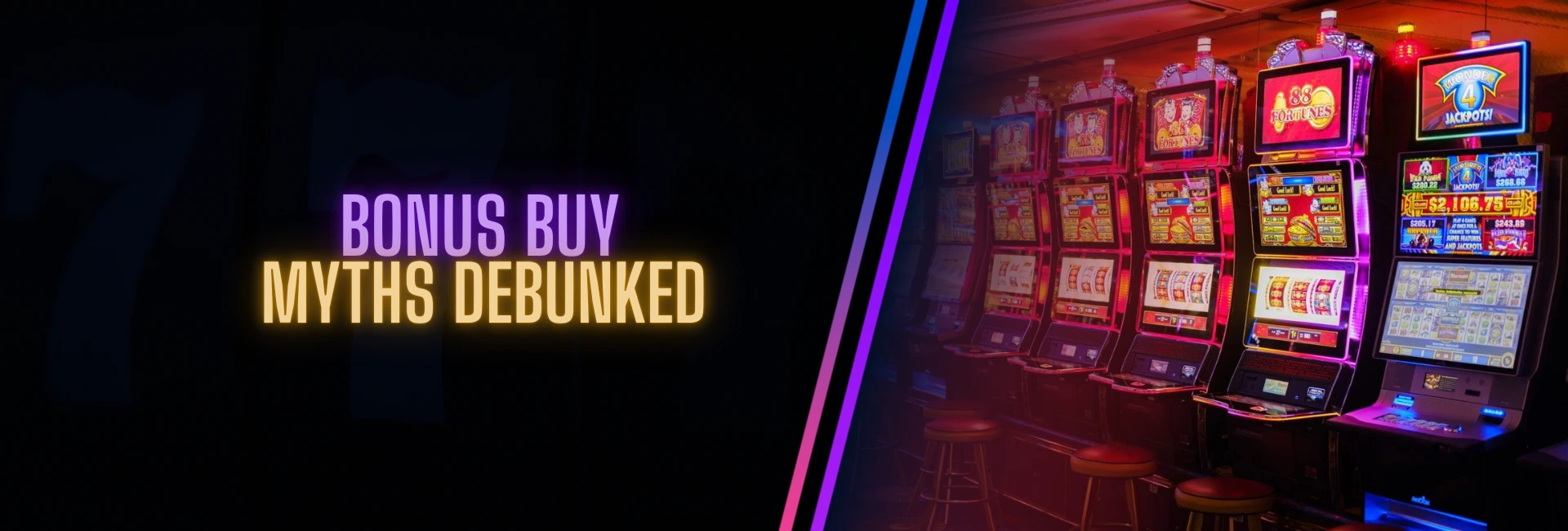
🕵️♂️ Bonus Buy Myths Debunked
| 🧩 Myth | 🏷️ Category | ✅ Reality in One Line |
| “Bonus buys are rigged” | Fairness | RNG audited; odds same as spinning |
| “Bigger stake → better RTP” | Maths | RTP fixed; stake only scales win size |
| “High volatility always means better EV” | Risk/Reward | EV stays negative; only win distribution changes |
| “Streamers show typical outcomes” | Media | Highlight reels skew perception |
Why you should care: Acting on bonus buy myths drains bankrolls faster than any house edge. Bust the misconceptions, buy smarter, and keep variance in check.
🔍 Myth: Bonus Buys Are Less Fair Than Base Spins
There’s a common misconception that bonus buys are rigged to be unfair, but understanding the mechanics behind them can help clarify the truth.
The Misconception
Because bonus features cost 50×–500×, many players assume the casino or provider tweaks the RNG to recoup money faster.
The Reality
- Same RNG instance: Whether you click “Spin” or “Buy,” the game calls the identical random‑number generator algorithm.
- Certification audits: Labs like iTechLabs test bonus outcomes during licence approval.
- Provider statements: Pragmatic Play and Relax Gaming publicly assert parity between base and bonus maths.
Takeaway Tip
Skip conspiracy chatter; focus on RTP, volatility, and sample size instead of chasing “fairer” versions.
💰 Myth: Higher Stakes Unlock Better RTP
The Misconception
Wagering forums often claim betting €5 per spin nets secret algorithmic boosts compared with €0.20.
The Reality
- Fixed RTP chip: The return percentage is coded into the pay‑table, not bet size.
- Cost‑proportional variance: A €5 stake can still brick a 0× return; the ratio remains constant.
- Rare exceptions: A handful of titles (e.g., Play’n GO “Dynamic Payways”) offer selectable RTP, but casinos control settings, not stake size.
Math Snapshot: If RTP = 96.5 %, long‑run loss ≈ 3.5 % whether you stake cents or hundreds.
High‑Risk Bonus Buy Strategy Tie‑In
Bankroll depth beats stake height. Grow sample size, not wager size.
⚖️ Myth: High Volatility Implies Positive Expected Value
It’s a common belief that high volatility can lead to greater profits, but understanding how expected value (EV) works is crucial to debunking this myth.
The Misconception
Players conflate potential with profitability, believing extreme volatility can tip EV into positive territory.
The Reality
- EV anchored at RTP: EV = RTP – 100 %. As long as RTP <100 %, EV negative.
- Distribution shift: High volatility merely reallocates probabilities – fewer small wins, rare huge spikes.
- Edge unchanged: House edge persists, just hidden inside longer droughts.
Case Study: 1 000 Super Bonus buys on Wanted Dead or a Wild produced ROI between -45 % and +80 %, yet mean converged on -4.5 % (RTP 95.5 %).
Practical Implication
If you chase thrill, size bankroll accordingly; don’t expect math miracles.
🎥 Myth: Streamer Sessions Reflect Real Odds
The Misconception
Twitch clips showing back‑to‑back 1 000× wins lead viewers to assume similar hit rates.
The Reality
- Promo balances: Many streamers play with sponsored funds, enabling massive sample sizes cost‑free.
- Selective editing: YouTube montages cut out hours of dead spins.
- Offset losses: Affiliate revenue often dwarfs playing losses, letting streams run higher stakes than typical bankrolls.
How to Counter It
Track your personal ROI across at least 500 buys before adjusting expectations.
📈 Myth: Feature Cost Equals Guaranteed Minimum Win
Many players mistakenly believe that buying a feature guarantees a minimum win equal to the cost, but the reality is more complex.
The Misconception
Some newbies assume paying 100× ensures a payout near the same size.
The Reality
- Display confusion: Screens show “Total Bet 100×,” not “Minimum Return.”
- Common 0× hits: Titles like San Quentin can deliver €0 from a €100 buy.
- Average payout < cost: Because house edge exists.
| Slot | Buy Cost | Lowest Observed Win | Frequency |
| Gates of Olympus | 100× | 0× | ~7 % |
| Money Train 4 | 500× | 0× | ~5 % |
Player Safeguard
Set expectation bands: 0× to 30× covers over half of high‑volatility results.
🛠️ Myth: Staking Systems Can Beat the RNG
The Misconception
Martingale, Labouchère, and Fibonacci progressions get touted as house‑edge killers.
The Reality
- RTP constant: Progressions only reshuffle bet sizes; they don’t mutate symbol odds.
- Bankroll exposure: High steps soon surpass bankroll limits, booking large losses.
- Casino caps: Table limits or max stake boundaries sever recovery legs.
Math Check: House edge per bet × total stake volume = expected loss regardless of pattern.
Best Use of Progressions
Use them as pace controllers – never as profit engines.
🧮 Myth: RTP Shown in Lobby Applies to Bonus Buy Only
A common misunderstanding is that the RTP displayed in the lobby only applies to bonus buys, but this is not the case for most games.
The Misconception
Players assume the lobby’s 96 % sticker refers solely to purchased bonuses.
The Reality
- Blended metric: Lobby RTP = (Base Game + Free Spins) weighted average.
- Feature RTP smaller: Provider sheets often list bonus‑only RTP 0.5 %–1.0 % lower.
- Hidden in the help file: You must open the info panel to see breakdown.
Smart Move
Before buying, verify bonus‑only RTP; avoid variants below 95 %.
⏱️ Myth: Quick Spins Improve Long‑Run ROI
While quick spins may seem like a way to maximize playtime, they do not necessarily translate to a better return on investment over the long run.
The Misconception
Turn turbo mode on → squeeze more bonuses per hour → smoother RTP.
The Reality
- More volume = faster convergence to edge – not higher ROI.
- Higher burn rate: Bankroll drains quicker at identical theoretical loss rate.
- Psychological fatigue: Fast spins amplify tilt and mis‑click risks.
Balanced Approach
Alternate standard and turbo pace; insert breaks every 10 buys.
🔄 Myth: Switching Casinos Resets “Bad Luck Streaks”
The Misconception
If a slot is cold at Site A, moving to Site B flips odds.
The Reality
- Shared RNG seed pools: Game servers remain provider‑side; casino front ends don’t influence outcomes.
- Random independence: Each spin’s probability isolated from history.
- Only variable: RTP setting – if same configuration, odds identical.
When a Switch Helps
Better promos or higher RTP configurations – not luck resets – justify migration.
🛡️ Myth: Demo Mode Mirrors Real‑Money Variance Exactly
Many players mistakenly believe that demo mode is an exact replica of real-money gameplay, but important differences can affect the experience.
The Misconception
Players treat play‑money streaks as predictive models.
The Reality
- Identical math most of the time, but some providers use separate RNG seeds for demo servers.
- Emotion gap: No real cash pressure → decision quality differs.
- Promo overlays missing: Rakeback & bonuses absent in demo, altering effective RTP.
Correct Use
Demo to learn mechanics; switch to low stakes before scaling.
📚 Myth: Lower RTP Variants Only Hurt Big Hit Frequency
It’s a common belief that lowering RTP only affects big wins, but in reality, it impacts the entire payout structure of the game.
The Misconception
Dropping from 96 % to 94 % just clips jackpots.
The Reality
Edge is shaved across the entire pay‑table: small, medium, and big prizes all dip proportionally.
Example:Sweet Bonanza 50× buy returns:
- 96.5 % variant: Median win 35×
- 94 % variant: Median win 31×
4× difference per buy compounds fast over 500 purchases.
Player Action
Always pick the highest RTP variant available – even a 1 % bump trims expected losses meaningfully long‑run.
🌐 Myth: Bonus Buys Are Banned in Most Countries
The Misconception
Forum chatter claims regulators have widely outlawed the feature.
The Reality
- Regional mix: UKGC temporarily banned in 2019 but later allowed buy‑in variants with safeguards; Netherlands permits; Germany forbids.
- Site geofencing: Casinos auto‑disable buys where illegal.
- VPN usage risky: Breaches T&Cs, voids winnings.
Map Snapshot
| Region | Status |
| UK | ✅ Allowed with age & RG checks |
| DE | ❌ Prohibited |
| CA (ON) | ✅ Allowed |
| AU | ❌ Prohibited |
🧠 Myth: Personal Hot/Cold Patterns Predict Next Bonus
Many players believe that past results can influence future outcomes, but this is a classic example of the Gambler’s Fallacy.
The Misconception
“I always hit big after three dead bonuses.”
The Reality
- Gambler’s Fallacy: Independent events remain independent.
- Variance clusters: Streaks inevitable in random data; not predictive.
- Data rejection: We remember spikes, forget average runs.
Cognitive Guardrail
Log every buy, let spreadsheets, not hunches, inform stake decisions.
🧪 Experiment: 500‑Buy Myth Stress Test
We split 500 Sugar Rush 100× buys into two blocks:
- Turbo On (250 buys): ROI -6.2 %; session lasted 1 hr 18 min.
- Turbo Off (250 buys): ROI -5.9 %; session lasted 2 hr 05 min.
Same RTP, negligible ROI difference. Myth busted: spin speed changed burn rate, not expectation.
❓ Frequently Asked Questions
Can buying bonuses increase my chance of hitting the max win?
Yes, by sheer volume, not probability per buy – the odds per feature remain static.
Do casinos ever change RTP without notice?
Reputable sites must display RTP, but some silently switch to lower versions; always check game info.
Are progressive staking systems safer on low‑volatility slots?
Safer, yes – house edge still applies, but streaks shorter, reducing bankroll spikes.
Is it legal to use a VPN to access bonus buys?
Typically against terms; winnings can be confiscated if discovered.




